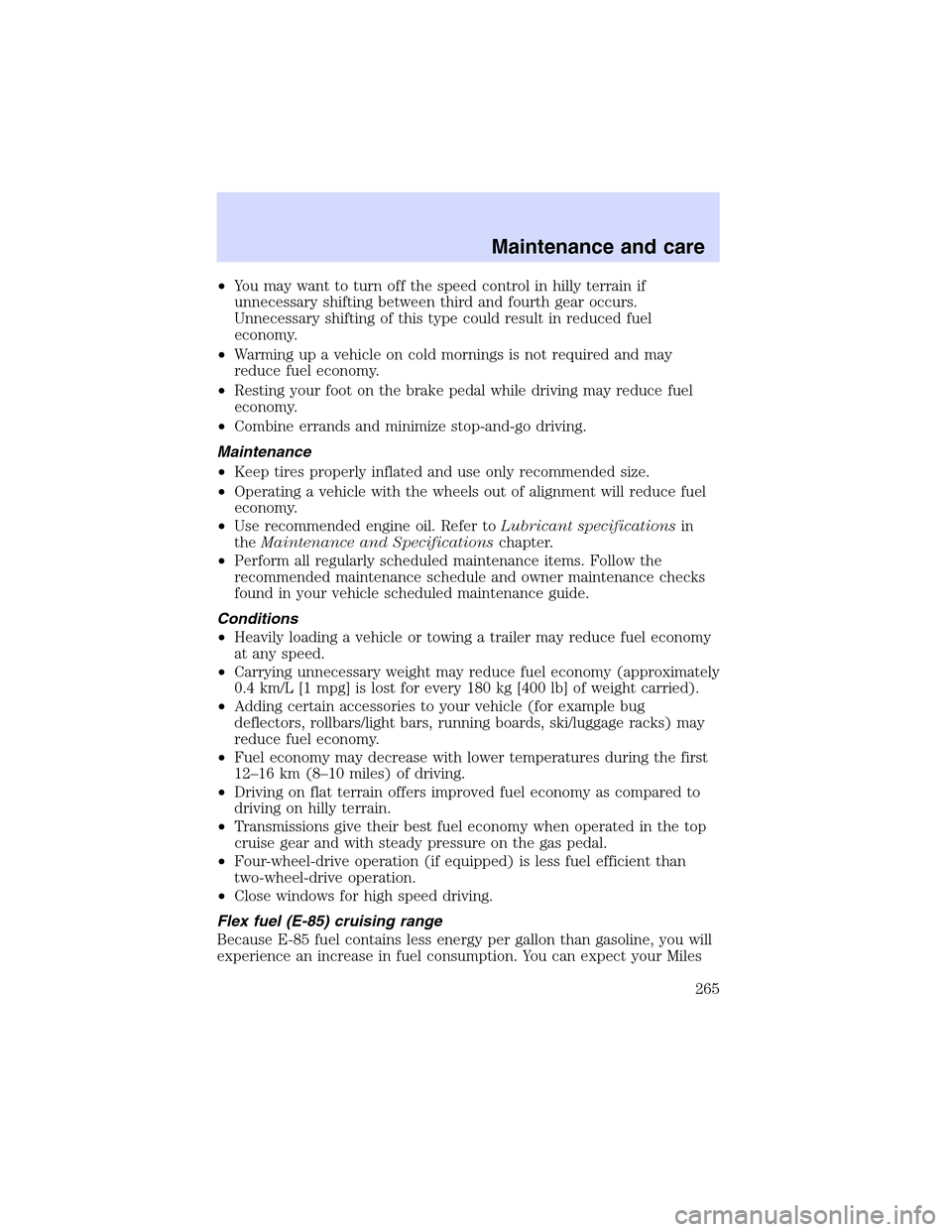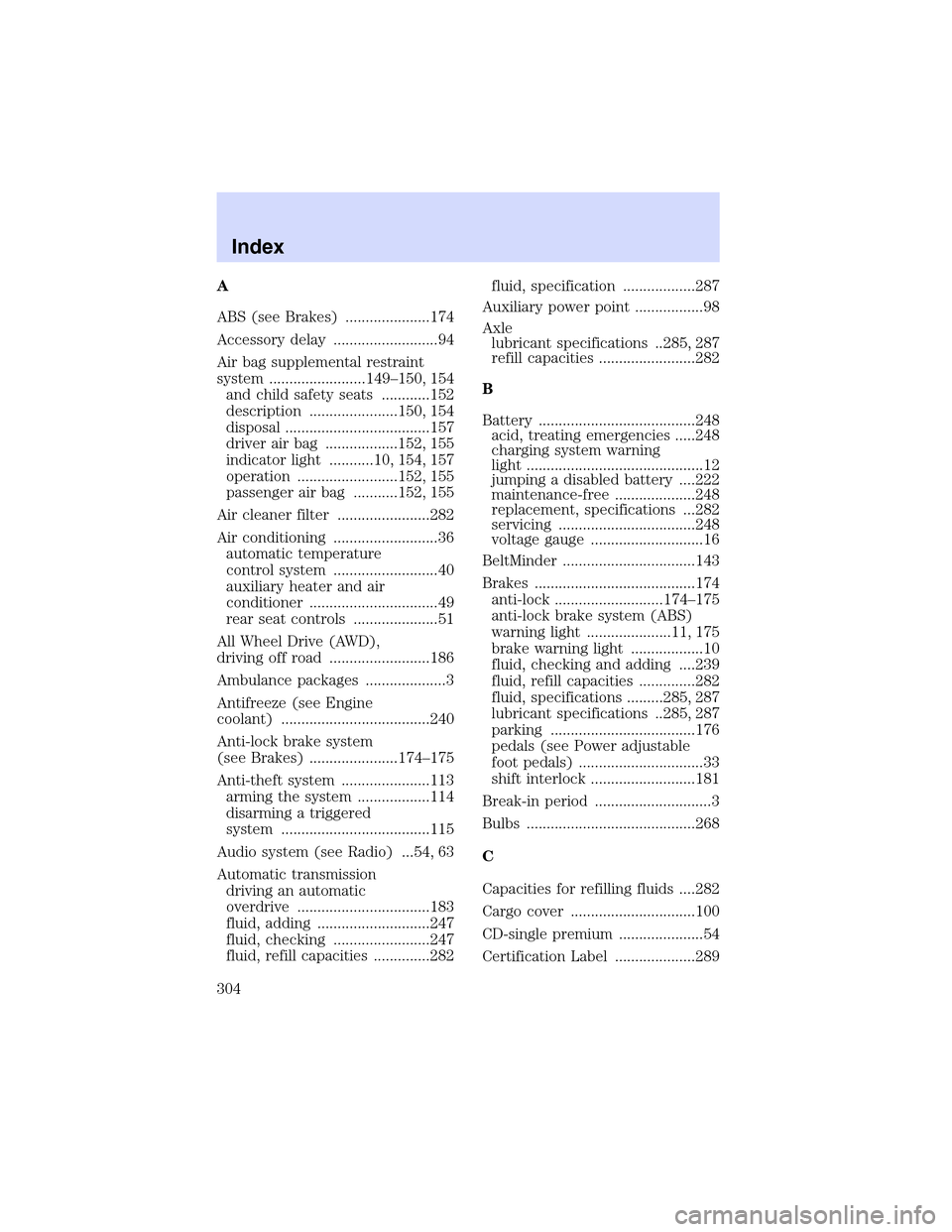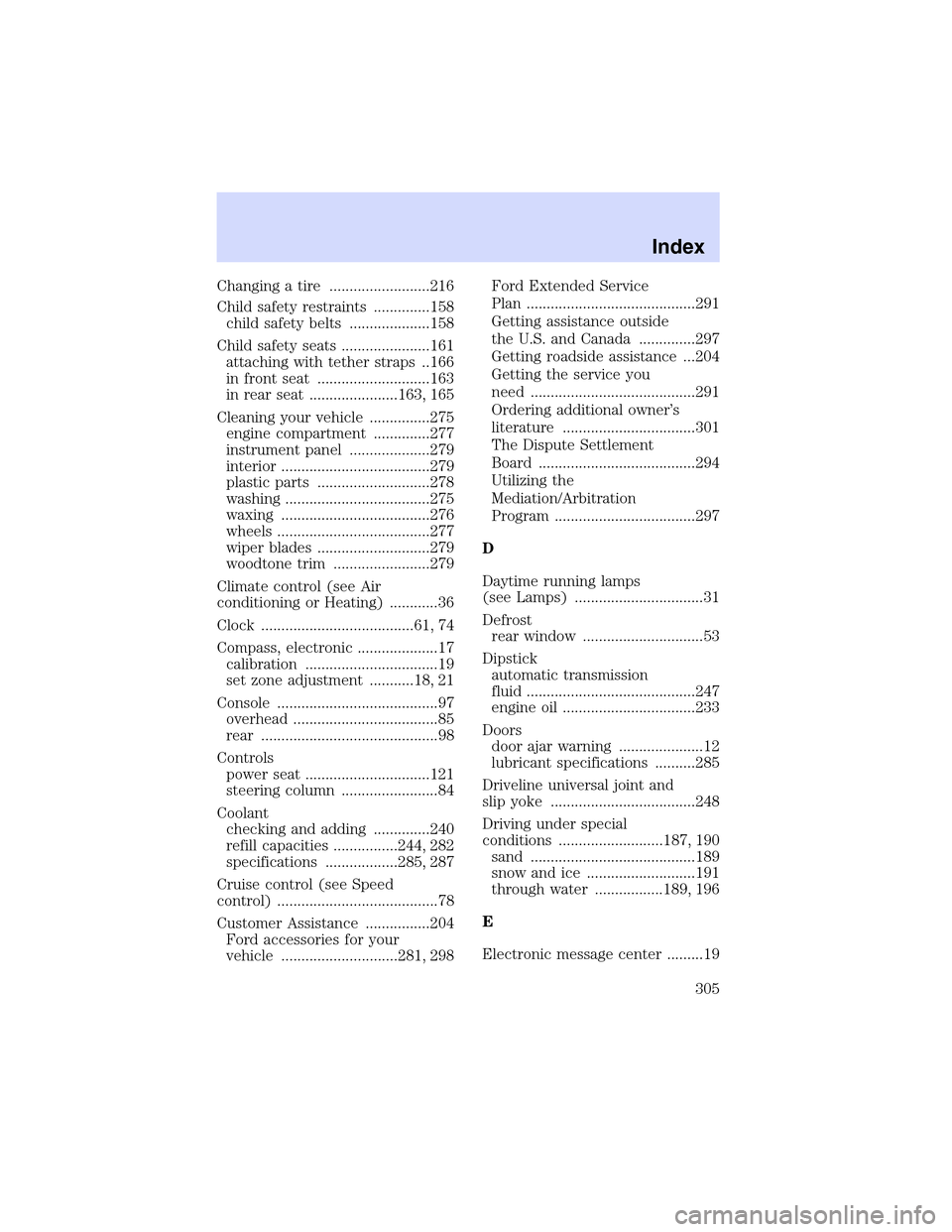check engine Mercury Mountaineer 2002 s Owner's Guide
[x] Cancel search | Manufacturer: MERCURY, Model Year: 2002, Model line: Mountaineer, Model: Mercury Mountaineer 2002Pages: 312, PDF Size: 3.02 MB
Page 261 of 312

rating. Aftermarket products could cause damage to the fuel system.
Repairs to correct the effects of using an aftermarket product in your
fuel may not be covered by your warranty.
Unleaded Gasoline engines
If you are experiencing starting, rough idle or hesitation driveability
problems during a cold start, try a different brand of“Regular”unleaded
gasoline.“Premium”unleaded gasoline is not recommended (particularly
in the United States) because it may cause these problems to become
more pronounced. If the problems persist, see your dealer or a qualified
service technician.
FFV engine (if equipped)
Your FFV will operate well on ordinary“Regular”unleaded gasoline, but
only the highest quality fuel ethanol will provide the same level of
protection and performance. To identify if your vehicle is an FFV, check
your VIN or the label on the inside of your fuel filler door. When
checking the VIN, look for the engine type identifier (8th character). If
your vehicle is an FFV, then the character will be labeled as a“K.”
If you operate your vehicle 50% or more of the time on ethanol, you
should follow a different maintenance schedule. See theScheduled
Maintenance Guidefor more information.
If you are experiencing a rough or rolling idle after start-up with the
outside temperature above 27°C (80°F), the idle should improve within
10 to 30 seconds. If the problems persist below this temperature, see
your dealer or a qualified service technician.
Cleaner air
Ford endorses the use of reformulated“cleaner-burning”gasolines to
improve air quality.
Running out of fuel
Avoid running out of fuel because this situation may have an adverse
affect on powertrain components.
If you have run out of fuel:
•You may need to cycle the ignition from OFF to ON several times after
refueling, to allow the fuel system to pump the fuel from the tank to
the engine.
Fuel Filler Cap
Your fuel tank filler cap has an indexed design with a 1/8 turn on/off
feature.
Maintenance and care
261
Page 262 of 312

When fueling your vehicle:
1. Turn the engine off.
2. Carefully turn the filler cap counterclockwise 1/8 of a turn until it
stops.
3. Pull to remove the cap from the fuel filler pipe.
4. To install the cap, align the tabs on the cap with the notches on the
filler pipe.
5. Turn the filler cap clockwise 1/8 of a turn until it stops.
If the“Check Fuel Cap”indicator comes on and stays on after you start
the engine, the fuel filler cap may not be properly installed. Turn off the
engine, remove the fuel filler cap, align the cap properly and reinstall it.
If you must replace the fuel filler cap, replace it with a fuel filler
cap that is designed for your vehicle. The customer warranty may
be void for any damage to the fuel tank or fuel system if the
correct genuine Ford or Motorcraft fuel filler cap is not used.
The fuel system may be under pressure. If the fuel filler cap is
venting vapor or if you hear a hissing sound, wait until it stops
before completely removing the fuel filler cap. Otherwise, fuel may
spray out and injure you or others.
If you do not use the proper fuel filler cap, excessive pressure or
vacuum in the fuel tank may damage the fuel system or cause
the fuel cap to disengage in a collision, which may result in possible
personal injury.
Fuel Filter
For fuel filter replacement, see your dealer or a qualified service
technician. Refer to the scheduled maintenance guide for the appropriate
intervals for changing the fuel filter.
Replace the fuel filter with an authorized Motorcraft part. The
customer warranty may be void for any damage to the fuel system
if an authorized Motorcraft fuel filter is not used.
ESSENTIALS OF GOOD FUEL ECONOMY
Measuring techniques
Your best source of information about actual fuel economy is you, the
driver. You must gather information as accurately and consistently as
Maintenance and care
262
Page 265 of 312

•You may want to turn off the speed control in hilly terrain if
unnecessary shifting between third and fourth gear occurs.
Unnecessary shifting of this type could result in reduced fuel
economy.
•Warming up a vehicle on cold mornings is not required and may
reduce fuel economy.
•Resting your foot on the brake pedal while driving may reduce fuel
economy.
•Combine errands and minimize stop-and-go driving.
Maintenance
•Keep tires properly inflated and use only recommended size.
•Operating a vehicle with the wheels out of alignment will reduce fuel
economy.
•Use recommended engine oil. Refer toLubricant specificationsin
theMaintenance and Specificationschapter.
•Perform all regularly scheduled maintenance items. Follow the
recommended maintenance schedule and owner maintenance checks
found in your vehicle scheduled maintenance guide.
Conditions
•Heavily loading a vehicle or towing a trailer may reduce fuel economy
at any speed.
•Carrying unnecessary weight may reduce fuel economy (approximately
0.4 km/L [1 mpg] is lost for every 180 kg [400 lb] of weight carried).
•Adding certain accessories to your vehicle (for example bug
deflectors, rollbars/light bars, running boards, ski/luggage racks) may
reduce fuel economy.
•Fuel economy may decrease with lower temperatures during the first
12–16 km (8–10 miles) of driving.
•Driving on flat terrain offers improved fuel economy as compared to
driving on hilly terrain.
•Transmissions give their best fuel economy when operated in the top
cruise gear and with steady pressure on the gas pedal.
•Four-wheel-drive operation (if equipped) is less fuel efficient than
two-wheel-drive operation.
•Close windows for high speed driving.
Flex fuel (E-85) cruising range
Because E-85 fuel contains less energy per gallon than gasoline, you will
experience an increase in fuel consumption. You can expect your Miles
Maintenance and care
265
Page 266 of 312

Per Gallon (MPG) and your driving range to decrease by about 30%
compared to gasoline operation.
EPA window sticker
Every new vehicle should have the EPA window sticker. Contact your
dealer if the window sticker is not supplied with your vehicle. The EPA
window sticker should be your guide for the fuel economy comparisons
with other vehicles.
It is important to note the box in the lower left corner of the window
sticker. These numbers represent the Range of L/100 km (MPG)
expected on the vehicle under optimum conditions. Your fuel economy
may vary depending upon the method of operation and conditions.
EMISSION CONTROL SYSTEM
Your vehicle is equipped with various emission control components and a
catalytic converter which will enable your vehicle to comply with
applicable exhaust emission standards. To make sure that the catalytic
converter and other emission control components continue to work
properly:
•Use only the specified fuel listed.
•Avoid running out of fuel.
•Do not turn off the ignition while your vehicle is moving, especially at
high speeds.
•Have the items listed in your scheduled maintenance guide performed
according to the specified schedule.
The scheduled maintenance items listed in the scheduled maintenance
guide are essential to the life and performance of your vehicle and to its
emissions system.
If other than Ford, Motorcraft or Ford-authorized parts are used for
maintenance replacements or for service of components affecting
emission control, such non-Ford parts should be equivalent to genuine
Ford Motor Company parts in performance and durability.
Do not park, idle, or drive your vehicle in dry grass or other dry
ground cover. The emission system heats up the engine
compartment and exhaust system, which can start a fire.
Illumination of the“Check Engine”light, charging system warning light
or the temperature warning light, fluid leaks, strange odors, smoke or
loss of engine power, could indicate that the emission control system is
not working properly.
Maintenance and care
266
Page 267 of 312

Exhaust leaks may result in entry of harmful and potentially
lethal fumes into the passenger compartment.
Do not make any unauthorized changes to your vehicle or engine. By
law, vehicle owners and anyone who manufactures, repairs, services,
sells, leases, trades vehicles, or supervises a fleet of vehicles are not
permitted to intentionally remove an emission control device or prevent
it from working. Information about your vehicle’s emission system is on
the Vehicle Emission Control Information Decal located on or near the
engine. This decal identifies engine displacement and gives some tune up
specifications.
Please consult yourWarranty Guidefor complete emission warranty
information.
Readiness for Inspection/Maintenance (I/M) testing
In some localities, it may be a legal requirement to pass an I/M test of
the on-board diagnostics system. If your“Check Engine/Service Engine
Soon”light is on, refer to the description in theWarning lights and
chimessection of theInstrumentationchapter. Your vehicle may not
pass the I/M test with the“Check Engine/Service Engine Soon”light on.
If the vehicle’s powertrain system or its battery has just been serviced,
the on-board diagnostics system is reset to a“not ready for I/M test”
condition. To ready the on-board diagnostics system for I/M testing, a
minimum of 30 minutes of city and highway driving is necessary as
described below:
•First, at least 10 minutes of driving on an expressway or highway.
•Next, at least 20 minutes driving in stop-and-go, city-type traffic with
at least four idle periods.
Allow the vehicle to sit for at least eight hours without starting the
engine. Then, start the engine and complete the above driving cycle. The
engine must warm up to its normal operating temperature. Once started,
do not turn off the engine until the above driving cycle is complete.
Maintenance and care
267
Page 290 of 312

1. World manufacturer identifier
2. Brake type and gross vehicle
weight rating (GVWR)
3. Vehicle line, series, body type
4. Engine type
5. Check digit
6. Model year
7. Assembly plant
8. Production sequence number
Engine number
The engine number (the last eight numbers of the vehicle identification
number) is stamped on the engine block, transmission, frame and
transfer case (if equipped).
Capacities and specifications
290
Page 301 of 312

For maximum vehicle performance, keep the following information in
mind when adding accessories or equipment to your vehicle:
•When adding accessories, equipment, passengers and luggage to your
vehicle, do not exceed the total weight capacity of the vehicle or of
the front or rear axle (GVWR or GAWR as indicated on the Safety
compliance certification label). Consult your dealer for specific weight
information.
•The Federal Communications Commission (FCC) and Canadian Radio
Telecommunications Commission (CRTC) regulate the use of mobile
communications systems - such as two-way radios, telephones and
theft alarms - that are equipped with radio transmitters. Any such
equipment installed in your vehicle should comply with FCC or CRTC
regulations and should be installed only by a qualified service
technician.
•Mobile communications systems may harm the operation of your
vehicle, particularly if they are not properly designed for automotive
use or are not properly installed. When operated, such systems may
cause the engine to stumble or stall or cause the transmission to be
damaged or operate improperly. In addition, such systems may be
damaged or their performance may be affected by operating your
vehicle. (Citizens band [CB] transceivers, garage door openers and
other transmitters with outputs of five watts or less will not ordinarily
affect your vehicle’s operation.)
•Ford cannot assume responsibility for any adverse effects or damage
that may result from the use of such equipment.
ORDERING ADDITIONAL OWNER’S LITERATURE
To order the publications in this portfolio, contact Helm, Incorporated at:
HELM, INCORPORATED
P.O. Box 07150
Detroit, Michigan 48207
Or call:
For a free publication catalog, order toll free: 1-800-782-4356
Monday-Friday 8:00 a.m. - 6:00 p.m. EST
Helm, Incorporated can also be reached by their website:
www.helminc.com.
(Items in this catalog may be purchased by credit card, check or
money order.)
Customer assistance
301
Page 304 of 312

A
ABS(see Brakes) .....................174
Accessory delay ..........................94
Air bag supplemental restraint
system ........................149–150, 154
and child safety seats ............152
description ......................150, 154
disposal ....................................157
driver air bag ..................152, 155
indicator light ...........10, 154, 157
operation .........................152, 155
passenger air bag ...........152, 155
Air cleaner filter .......................282
Air conditioning ..........................36
automatic temperature
control system ..........................40
auxiliary heater and air
conditioner ................................49
rear seat controls .....................51
All Wheel Drive (AWD),
driving off road .........................186
Ambulance packages ....................3
Antifreeze (see Engine
coolant) .....................................240
Anti-lock brake system
(see Brakes) ......................174–175
Anti-theft system ......................113
arming the system ..................114
disarming a triggered
system .....................................115
Audio system (see Radio) ...54, 63
Automatic transmission
driving an automatic
overdrive .................................183
fluid, adding ............................247
fluid, checking ........................247
fluid, refill capacities ..............282fluid, specification ..................287
Auxiliary power point .................98
Axle
lubricant specifications ..285, 287
refill capacities ........................282
B
Battery .......................................248
acid, treating emergencies .....248
charging system warning
light ............................................12
jumping a disabled battery ....222
maintenance-free ....................248
replacement, specifications ...282
servicing ..................................248
voltage gauge ............................16
BeltMinder .................................143
Brakes ........................................174
anti-lock ...........................174–175
anti-lock brake system (ABS)
warning light .....................11, 175
brake warning light ..................10
fluid, checking and adding ....239
fluid, refill capacities ..............282
fluid, specifications .........285, 287
lubricant specifications ..285, 287
parking ....................................176
pedals (see Power adjustable
foot pedals) ...............................33
shift interlock ..........................181
Break-in period .............................3
Bulbs ..........................................268
C
Capacities for refilling fluids ....282
Cargo cover ...............................100
CD-single premium .....................54
Certification Label ....................289
Index
304
Page 305 of 312

Changing a tire .........................216
Child safety restraints ..............158
child safety belts ....................158
Child safety seats ......................161
attaching with tether straps ..166
in front seat ............................163
in rear seat ......................163, 165
Cleaning your vehicle ...............275
engine compartment ..............277
instrument panel ....................279
interior .....................................279
plastic parts ............................278
washing ....................................275
waxing .....................................276
wheels ......................................277
wiper blades ............................279
woodtone trim ........................279
Climate control (see Air
conditioning or Heating) ............36
Clock ......................................61, 74
Compass, electronic ....................17
calibration .................................19
set zone adjustment ...........18, 21
Console ........................................97
overhead ....................................85
rear ............................................98
Controls
power seat ...............................121
steering column ........................84
Coolant
checking and adding ..............240
refill capacities ................244, 282
specifications ..................285, 287
Cruise control (see Speed
control) ........................................78
Customer Assistance ................204
Ford accessories for your
vehicle .............................281, 298Ford Extended Service
Plan ..........................................291
Getting assistance outside
the U.S. and Canada ..............297
Getting roadside assistance ...204
Getting the service you
need .........................................291
Ordering additional owner’s
literature .................................301
The Dispute Settlement
Board .......................................294
Utilizing the
Mediation/Arbitration
Program ...................................297
D
Daytime running lamps
(see Lamps) ................................31
Defrost
rear window ..............................53
Dipstick
automatic transmission
fluid ..........................................247
engine oil .................................233
Doors
door ajar warning .....................12
lubricant specifications ..........285
Driveline universal joint and
slip yoke ....................................248
Driving under special
conditions ..........................187, 190
sand .........................................189
snow and ice ...........................191
through water .................189, 196
E
Electronic message center .........19
Index
305
Page 306 of 312

Emergencies, roadside
jump-starting ..........................222
Emission control system ..........266
Engine ........................................287
check engine/service engine
soon light ....................................9
cleaning ...................................277
coolant .....................................240
fail-safe coolant ......................244
idle speed control ...................248
lubrication
specifications ..................285, 287
refill capacities ........................282
service points ..................232–233
starting after a collision .........205
Engine block heater .................172
Engine oil ..................................233
checking and adding ..............233
dipstick ....................................233
filter, specifications ........237, 282
recommendations ...................237
refill capacities ........................282
specifications ..................285, 287
Exhaust fumes ..........................173
F
Fail safe cooling ........................244
Flexible Fuel Vehicle (FFV) ....257
Floor mats ...................................99
Fluid capacities .........................282
Foglamps .....................................31
Four-Wheel Drive vehicles
driving off road .......................186
preparing to drive your
vehicle .....................................180
Fuel ............................................257calculating fuel
economy ............................22, 262
cap .....................................10, 261
capacity ...................................282
choosing the right fuel ...........259
comparisons with EPA fuel
economy estimates .................266
detergent in fuel .....................261
filling your vehicle with
fuel ...........................257, 261, 263
filter, specifications ........262, 282
fuel pump shut-off switch .....205
gauge .........................................17
improving fuel economy ........262
octane rating ...................260, 287
quality ......................................260
running out of fuel .................261
safety information relating to
automotive fuels .....................257
Fuel - flex fuel vehicle
(FFV) .........................257, 259–260
Fuses ..................................206–207
G
Garage door opener ..............86, 88
Gas cap (see Fuel cap) ......10, 261
Gas mileage (see Fuel
economy) ...................................262
Gauges .........................................14
battery voltage gauge ...............16
engine coolant temperature
gauge .........................................15
engine oil pressure gauge ........17
fuel gauge ..................................17
odometer ...................................15
speedometer .............................14
tachometer ................................16
trip odometer ............................16
Index
306